MacInnes v Gross: A Business Law Case Study on Contract Law Principles
VerifiedAdded on 2020/05/08
|7
|1329
|93
Case Study
AI Summary
This case study analyzes the business law case of MacInnes v Gross, focusing on contract formation. The case involves a dispute over an alleged breach of contract following a dinner meeting where an agreement was discussed. The analysis examines the elements of a contract, including offer and acceptance, consideration, and intention to create legal relations. The court's decision emphasizes the importance of intention and the context in which agreements are made, particularly in informal settings. The study also explores whether a breach of contract could be cited and if a written agreement would have changed the outcome. The document concludes with a bibliography of relevant sources, including cases, articles, and books related to contract law.
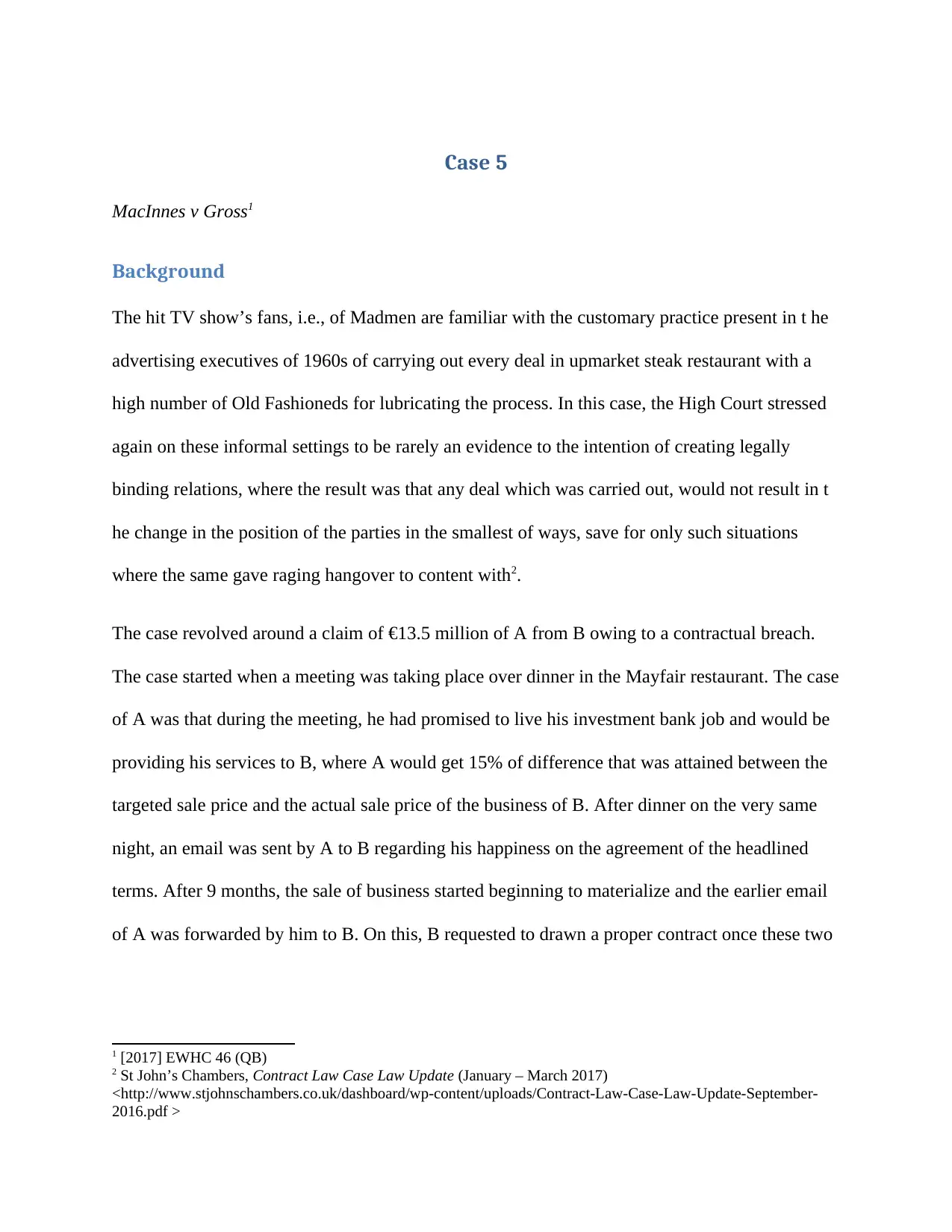
Case 5
MacInnes v Gross1
Background
The hit TV show’s fans, i.e., of Madmen are familiar with the customary practice present in t he
advertising executives of 1960s of carrying out every deal in upmarket steak restaurant with a
high number of Old Fashioneds for lubricating the process. In this case, the High Court stressed
again on these informal settings to be rarely an evidence to the intention of creating legally
binding relations, where the result was that any deal which was carried out, would not result in t
he change in the position of the parties in the smallest of ways, save for only such situations
where the same gave raging hangover to content with2.
The case revolved around a claim of €13.5 million of A from B owing to a contractual breach.
The case started when a meeting was taking place over dinner in the Mayfair restaurant. The case
of A was that during the meeting, he had promised to live his investment bank job and would be
providing his services to B, where A would get 15% of difference that was attained between the
targeted sale price and the actual sale price of the business of B. After dinner on the very same
night, an email was sent by A to B regarding his happiness on the agreement of the headlined
terms. After 9 months, the sale of business started beginning to materialize and the earlier email
of A was forwarded by him to B. On this, B requested to drawn a proper contract once these two
1 [2017] EWHC 46 (QB)
2 St John’s Chambers, Contract Law Case Law Update (January – March 2017)
<http://www.stjohnschambers.co.uk/dashboard/wp-content/uploads/Contract-Law-Case-Law-Update-September-
2016.pdf >
MacInnes v Gross1
Background
The hit TV show’s fans, i.e., of Madmen are familiar with the customary practice present in t he
advertising executives of 1960s of carrying out every deal in upmarket steak restaurant with a
high number of Old Fashioneds for lubricating the process. In this case, the High Court stressed
again on these informal settings to be rarely an evidence to the intention of creating legally
binding relations, where the result was that any deal which was carried out, would not result in t
he change in the position of the parties in the smallest of ways, save for only such situations
where the same gave raging hangover to content with2.
The case revolved around a claim of €13.5 million of A from B owing to a contractual breach.
The case started when a meeting was taking place over dinner in the Mayfair restaurant. The case
of A was that during the meeting, he had promised to live his investment bank job and would be
providing his services to B, where A would get 15% of difference that was attained between the
targeted sale price and the actual sale price of the business of B. After dinner on the very same
night, an email was sent by A to B regarding his happiness on the agreement of the headlined
terms. After 9 months, the sale of business started beginning to materialize and the earlier email
of A was forwarded by him to B. On this, B requested to drawn a proper contract once these two
1 [2017] EWHC 46 (QB)
2 St John’s Chambers, Contract Law Case Law Update (January – March 2017)
<http://www.stjohnschambers.co.uk/dashboard/wp-content/uploads/Contract-Law-Case-Law-Update-September-
2016.pdf >
Paraphrase This Document
Need a fresh take? Get an instant paraphrase of this document with our AI Paraphraser
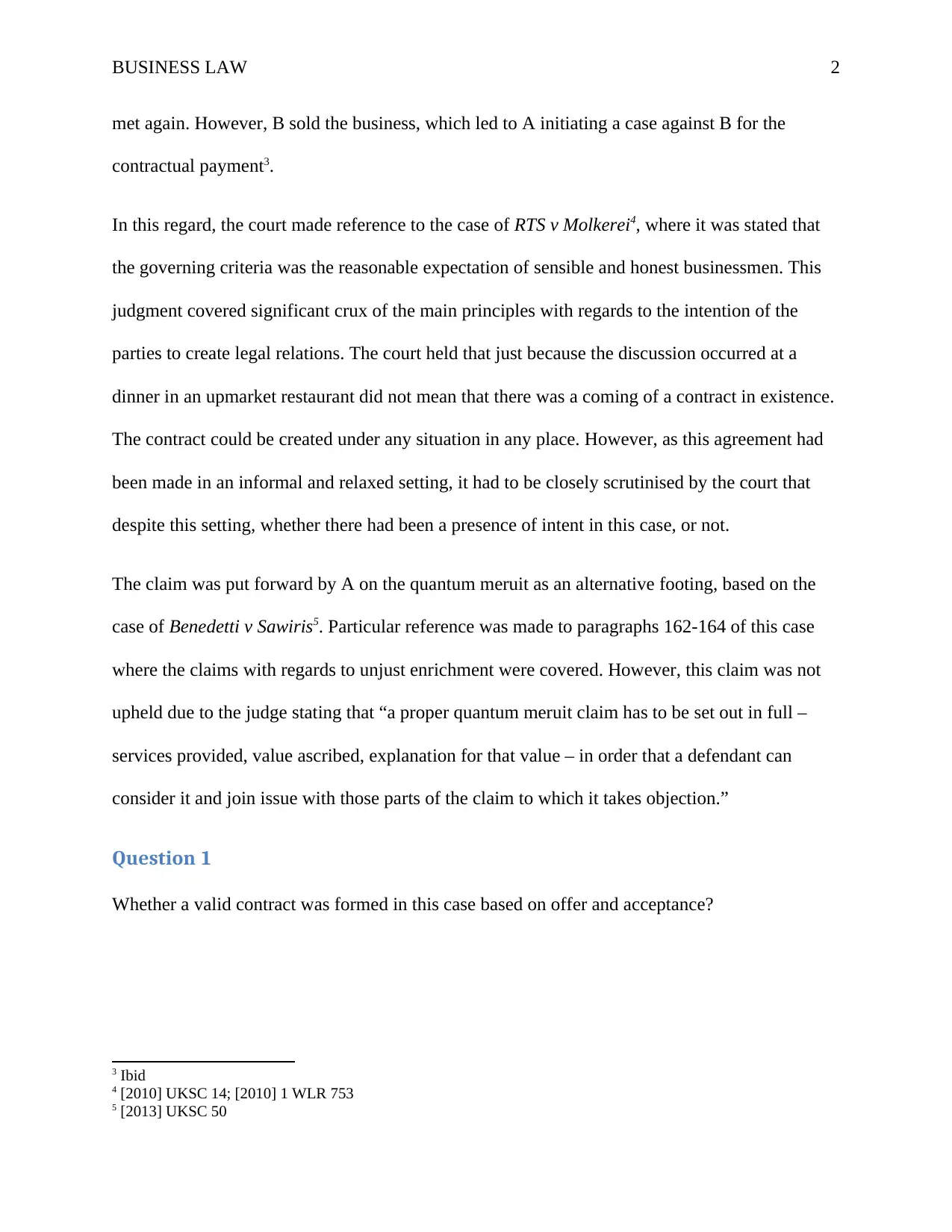
BUSINESS LAW 2
met again. However, B sold the business, which led to A initiating a case against B for the
contractual payment3.
In this regard, the court made reference to the case of RTS v Molkerei4, where it was stated that
the governing criteria was the reasonable expectation of sensible and honest businessmen. This
judgment covered significant crux of the main principles with regards to the intention of the
parties to create legal relations. The court held that just because the discussion occurred at a
dinner in an upmarket restaurant did not mean that there was a coming of a contract in existence.
The contract could be created under any situation in any place. However, as this agreement had
been made in an informal and relaxed setting, it had to be closely scrutinised by the court that
despite this setting, whether there had been a presence of intent in this case, or not.
The claim was put forward by A on the quantum meruit as an alternative footing, based on the
case of Benedetti v Sawiris5. Particular reference was made to paragraphs 162-164 of this case
where the claims with regards to unjust enrichment were covered. However, this claim was not
upheld due to the judge stating that “a proper quantum meruit claim has to be set out in full –
services provided, value ascribed, explanation for that value – in order that a defendant can
consider it and join issue with those parts of the claim to which it takes objection.”
Question 1
Whether a valid contract was formed in this case based on offer and acceptance?
3 Ibid
4 [2010] UKSC 14; [2010] 1 WLR 753
5 [2013] UKSC 50
met again. However, B sold the business, which led to A initiating a case against B for the
contractual payment3.
In this regard, the court made reference to the case of RTS v Molkerei4, where it was stated that
the governing criteria was the reasonable expectation of sensible and honest businessmen. This
judgment covered significant crux of the main principles with regards to the intention of the
parties to create legal relations. The court held that just because the discussion occurred at a
dinner in an upmarket restaurant did not mean that there was a coming of a contract in existence.
The contract could be created under any situation in any place. However, as this agreement had
been made in an informal and relaxed setting, it had to be closely scrutinised by the court that
despite this setting, whether there had been a presence of intent in this case, or not.
The claim was put forward by A on the quantum meruit as an alternative footing, based on the
case of Benedetti v Sawiris5. Particular reference was made to paragraphs 162-164 of this case
where the claims with regards to unjust enrichment were covered. However, this claim was not
upheld due to the judge stating that “a proper quantum meruit claim has to be set out in full –
services provided, value ascribed, explanation for that value – in order that a defendant can
consider it and join issue with those parts of the claim to which it takes objection.”
Question 1
Whether a valid contract was formed in this case based on offer and acceptance?
3 Ibid
4 [2010] UKSC 14; [2010] 1 WLR 753
5 [2013] UKSC 50
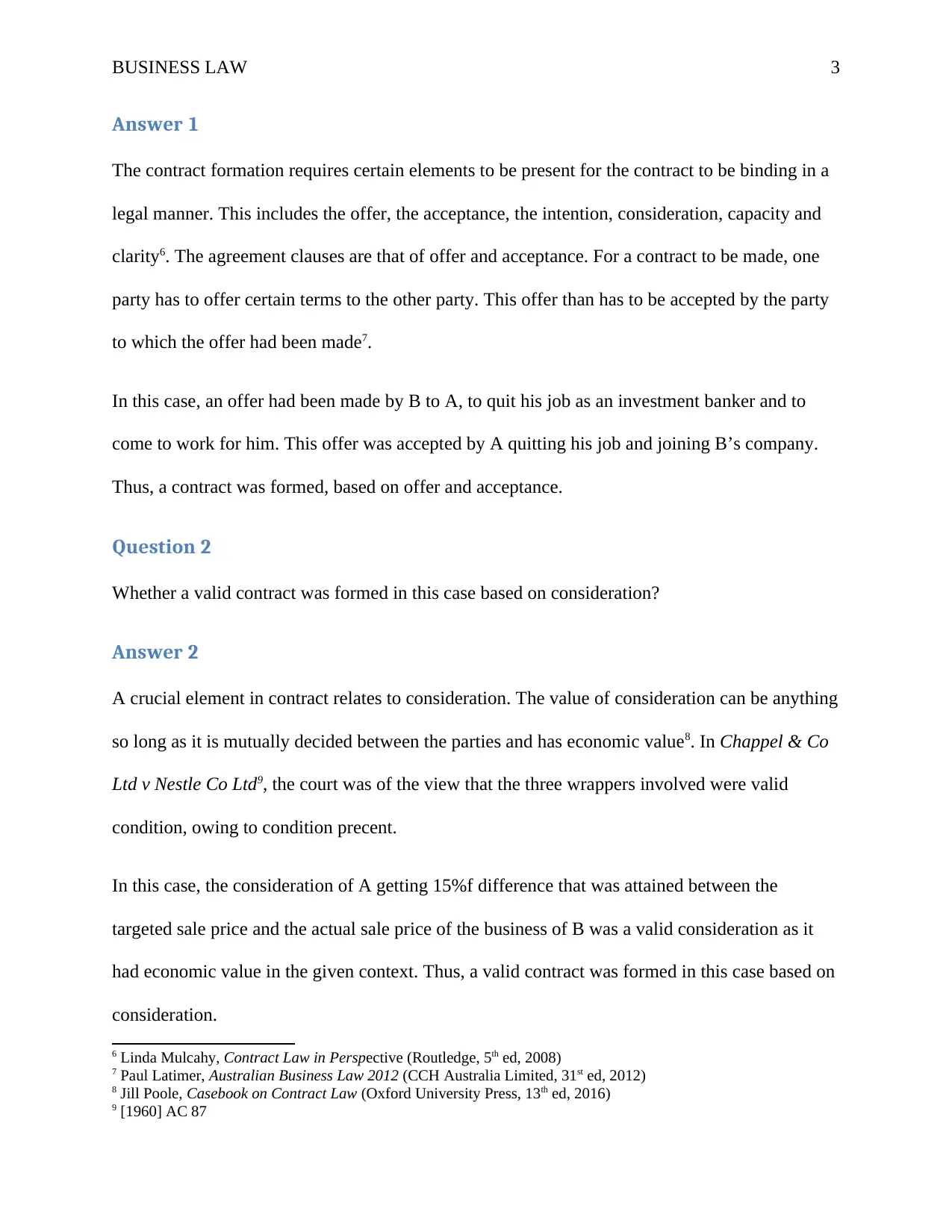
BUSINESS LAW 3
Answer 1
The contract formation requires certain elements to be present for the contract to be binding in a
legal manner. This includes the offer, the acceptance, the intention, consideration, capacity and
clarity6. The agreement clauses are that of offer and acceptance. For a contract to be made, one
party has to offer certain terms to the other party. This offer than has to be accepted by the party
to which the offer had been made7.
In this case, an offer had been made by B to A, to quit his job as an investment banker and to
come to work for him. This offer was accepted by A quitting his job and joining B’s company.
Thus, a contract was formed, based on offer and acceptance.
Question 2
Whether a valid contract was formed in this case based on consideration?
Answer 2
A crucial element in contract relates to consideration. The value of consideration can be anything
so long as it is mutually decided between the parties and has economic value8. In Chappel & Co
Ltd v Nestle Co Ltd9, the court was of the view that the three wrappers involved were valid
condition, owing to condition precent.
In this case, the consideration of A getting 15%f difference that was attained between the
targeted sale price and the actual sale price of the business of B was a valid consideration as it
had economic value in the given context. Thus, a valid contract was formed in this case based on
consideration.
6 Linda Mulcahy, Contract Law in Perspective (Routledge, 5th ed, 2008)
7 Paul Latimer, Australian Business Law 2012 (CCH Australia Limited, 31st ed, 2012)
8 Jill Poole, Casebook on Contract Law (Oxford University Press, 13th ed, 2016)
9 [1960] AC 87
Answer 1
The contract formation requires certain elements to be present for the contract to be binding in a
legal manner. This includes the offer, the acceptance, the intention, consideration, capacity and
clarity6. The agreement clauses are that of offer and acceptance. For a contract to be made, one
party has to offer certain terms to the other party. This offer than has to be accepted by the party
to which the offer had been made7.
In this case, an offer had been made by B to A, to quit his job as an investment banker and to
come to work for him. This offer was accepted by A quitting his job and joining B’s company.
Thus, a contract was formed, based on offer and acceptance.
Question 2
Whether a valid contract was formed in this case based on consideration?
Answer 2
A crucial element in contract relates to consideration. The value of consideration can be anything
so long as it is mutually decided between the parties and has economic value8. In Chappel & Co
Ltd v Nestle Co Ltd9, the court was of the view that the three wrappers involved were valid
condition, owing to condition precent.
In this case, the consideration of A getting 15%f difference that was attained between the
targeted sale price and the actual sale price of the business of B was a valid consideration as it
had economic value in the given context. Thus, a valid contract was formed in this case based on
consideration.
6 Linda Mulcahy, Contract Law in Perspective (Routledge, 5th ed, 2008)
7 Paul Latimer, Australian Business Law 2012 (CCH Australia Limited, 31st ed, 2012)
8 Jill Poole, Casebook on Contract Law (Oxford University Press, 13th ed, 2016)
9 [1960] AC 87
⊘ This is a preview!⊘
Do you want full access?
Subscribe today to unlock all pages.

Trusted by 1+ million students worldwide
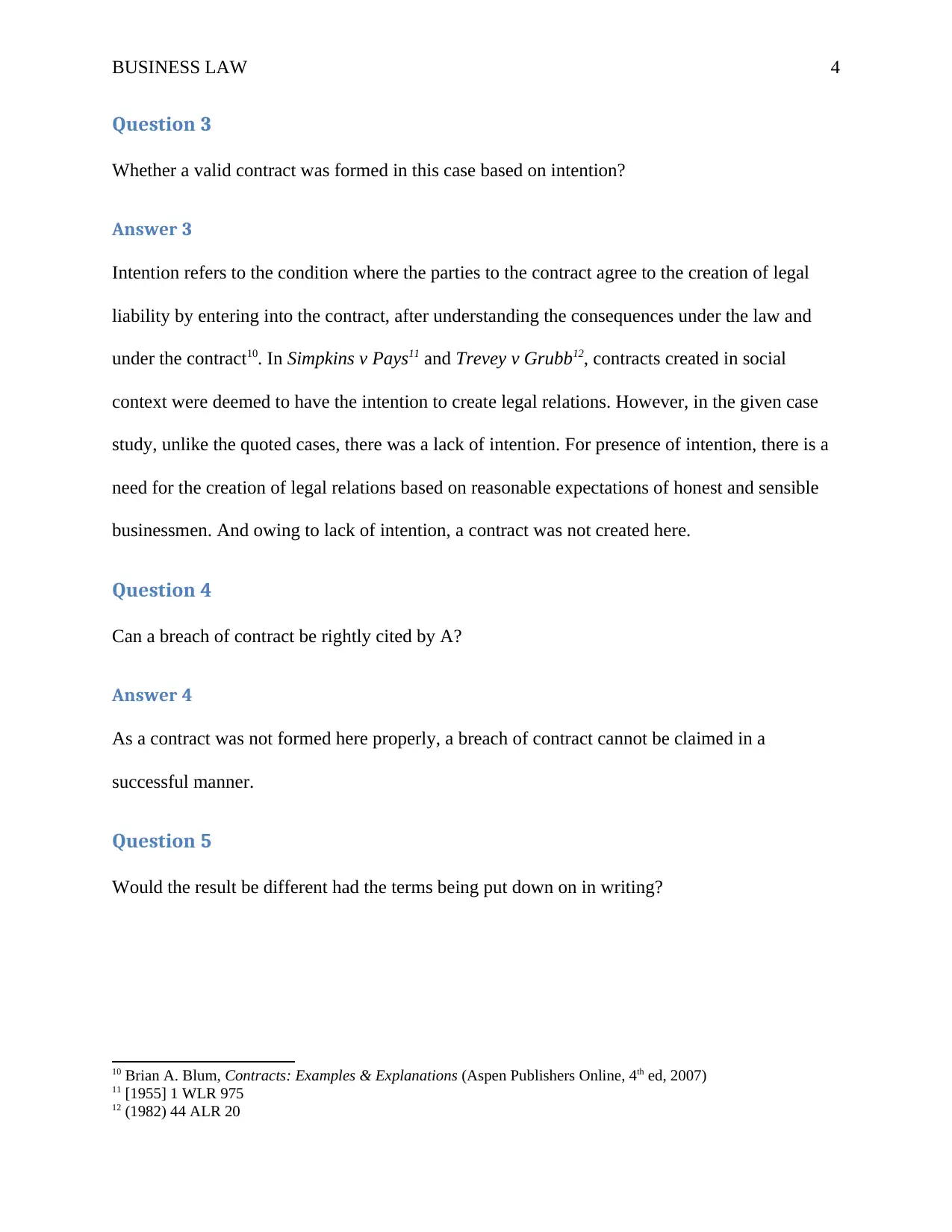
BUSINESS LAW 4
Question 3
Whether a valid contract was formed in this case based on intention?
Answer 3
Intention refers to the condition where the parties to the contract agree to the creation of legal
liability by entering into the contract, after understanding the consequences under the law and
under the contract10. In Simpkins v Pays11 and Trevey v Grubb12, contracts created in social
context were deemed to have the intention to create legal relations. However, in the given case
study, unlike the quoted cases, there was a lack of intention. For presence of intention, there is a
need for the creation of legal relations based on reasonable expectations of honest and sensible
businessmen. And owing to lack of intention, a contract was not created here.
Question 4
Can a breach of contract be rightly cited by A?
Answer 4
As a contract was not formed here properly, a breach of contract cannot be claimed in a
successful manner.
Question 5
Would the result be different had the terms being put down on in writing?
10 Brian A. Blum, Contracts: Examples & Explanations (Aspen Publishers Online, 4th ed, 2007)
11 [1955] 1 WLR 975
12 (1982) 44 ALR 20
Question 3
Whether a valid contract was formed in this case based on intention?
Answer 3
Intention refers to the condition where the parties to the contract agree to the creation of legal
liability by entering into the contract, after understanding the consequences under the law and
under the contract10. In Simpkins v Pays11 and Trevey v Grubb12, contracts created in social
context were deemed to have the intention to create legal relations. However, in the given case
study, unlike the quoted cases, there was a lack of intention. For presence of intention, there is a
need for the creation of legal relations based on reasonable expectations of honest and sensible
businessmen. And owing to lack of intention, a contract was not created here.
Question 4
Can a breach of contract be rightly cited by A?
Answer 4
As a contract was not formed here properly, a breach of contract cannot be claimed in a
successful manner.
Question 5
Would the result be different had the terms being put down on in writing?
10 Brian A. Blum, Contracts: Examples & Explanations (Aspen Publishers Online, 4th ed, 2007)
11 [1955] 1 WLR 975
12 (1982) 44 ALR 20
Paraphrase This Document
Need a fresh take? Get an instant paraphrase of this document with our AI Paraphraser
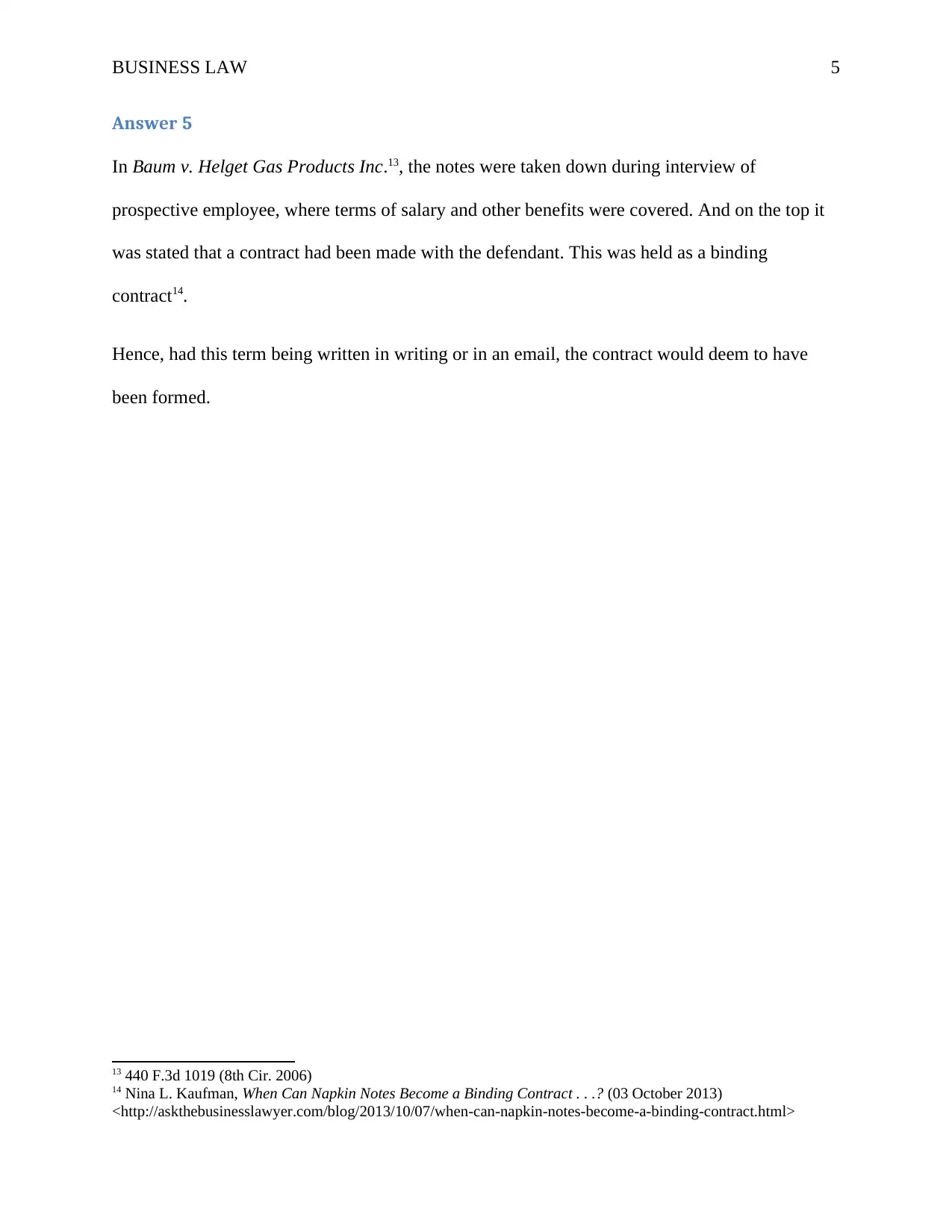
BUSINESS LAW 5
Answer 5
In Baum v. Helget Gas Products Inc.13, the notes were taken down during interview of
prospective employee, where terms of salary and other benefits were covered. And on the top it
was stated that a contract had been made with the defendant. This was held as a binding
contract14.
Hence, had this term being written in writing or in an email, the contract would deem to have
been formed.
13 440 F.3d 1019 (8th Cir. 2006)
14 Nina L. Kaufman, When Can Napkin Notes Become a Binding Contract . . .? (03 October 2013)
<http://askthebusinesslawyer.com/blog/2013/10/07/when-can-napkin-notes-become-a-binding-contract.html>
Answer 5
In Baum v. Helget Gas Products Inc.13, the notes were taken down during interview of
prospective employee, where terms of salary and other benefits were covered. And on the top it
was stated that a contract had been made with the defendant. This was held as a binding
contract14.
Hence, had this term being written in writing or in an email, the contract would deem to have
been formed.
13 440 F.3d 1019 (8th Cir. 2006)
14 Nina L. Kaufman, When Can Napkin Notes Become a Binding Contract . . .? (03 October 2013)
<http://askthebusinesslawyer.com/blog/2013/10/07/when-can-napkin-notes-become-a-binding-contract.html>
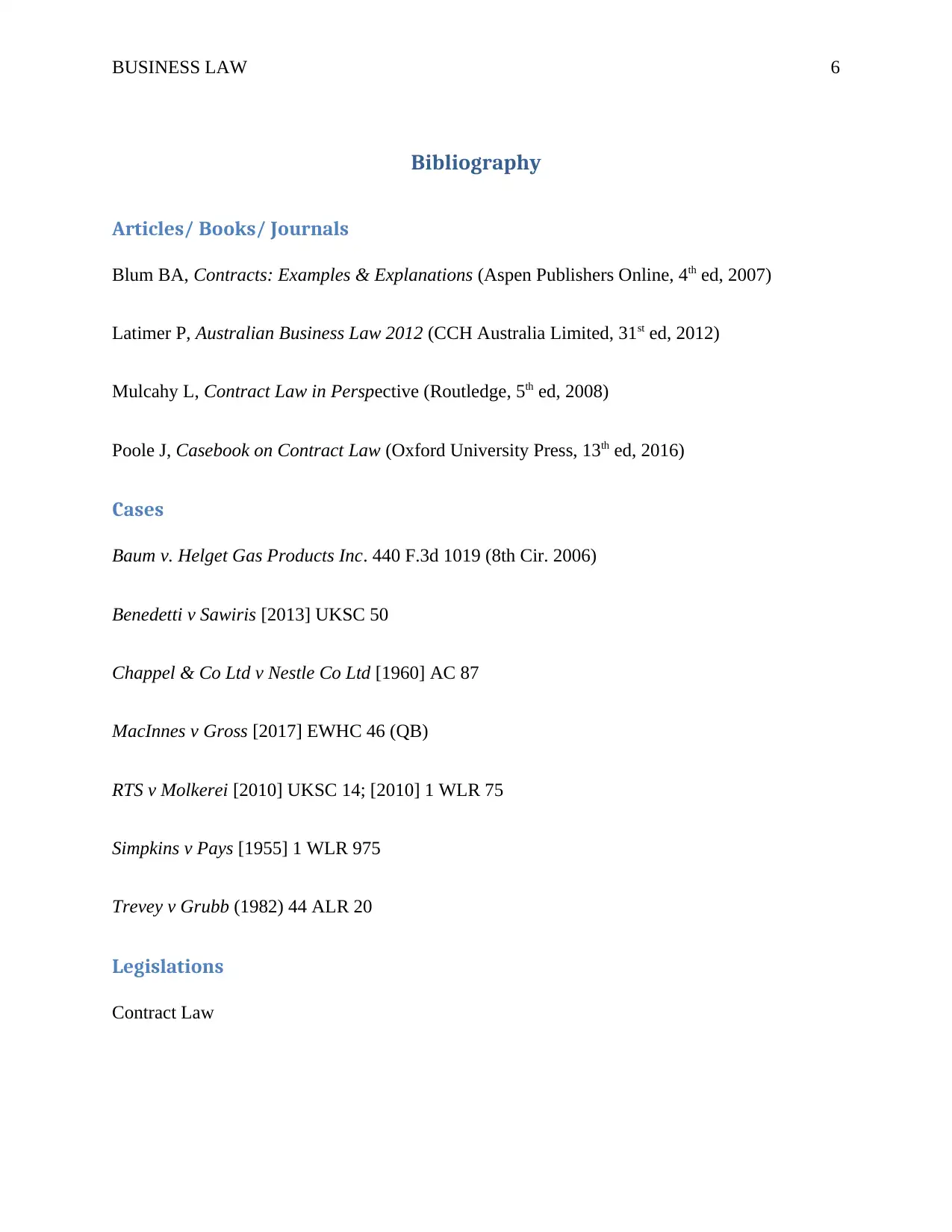
BUSINESS LAW 6
Bibliography
Articles/ Books/ Journals
Blum BA, Contracts: Examples & Explanations (Aspen Publishers Online, 4th ed, 2007)
Latimer P, Australian Business Law 2012 (CCH Australia Limited, 31st ed, 2012)
Mulcahy L, Contract Law in Perspective (Routledge, 5th ed, 2008)
Poole J, Casebook on Contract Law (Oxford University Press, 13th ed, 2016)
Cases
Baum v. Helget Gas Products Inc. 440 F.3d 1019 (8th Cir. 2006)
Benedetti v Sawiris [2013] UKSC 50
Chappel & Co Ltd v Nestle Co Ltd [1960] AC 87
MacInnes v Gross [2017] EWHC 46 (QB)
RTS v Molkerei [2010] UKSC 14; [2010] 1 WLR 75
Simpkins v Pays [1955] 1 WLR 975
Trevey v Grubb (1982) 44 ALR 20
Legislations
Contract Law
Bibliography
Articles/ Books/ Journals
Blum BA, Contracts: Examples & Explanations (Aspen Publishers Online, 4th ed, 2007)
Latimer P, Australian Business Law 2012 (CCH Australia Limited, 31st ed, 2012)
Mulcahy L, Contract Law in Perspective (Routledge, 5th ed, 2008)
Poole J, Casebook on Contract Law (Oxford University Press, 13th ed, 2016)
Cases
Baum v. Helget Gas Products Inc. 440 F.3d 1019 (8th Cir. 2006)
Benedetti v Sawiris [2013] UKSC 50
Chappel & Co Ltd v Nestle Co Ltd [1960] AC 87
MacInnes v Gross [2017] EWHC 46 (QB)
RTS v Molkerei [2010] UKSC 14; [2010] 1 WLR 75
Simpkins v Pays [1955] 1 WLR 975
Trevey v Grubb (1982) 44 ALR 20
Legislations
Contract Law
⊘ This is a preview!⊘
Do you want full access?
Subscribe today to unlock all pages.

Trusted by 1+ million students worldwide
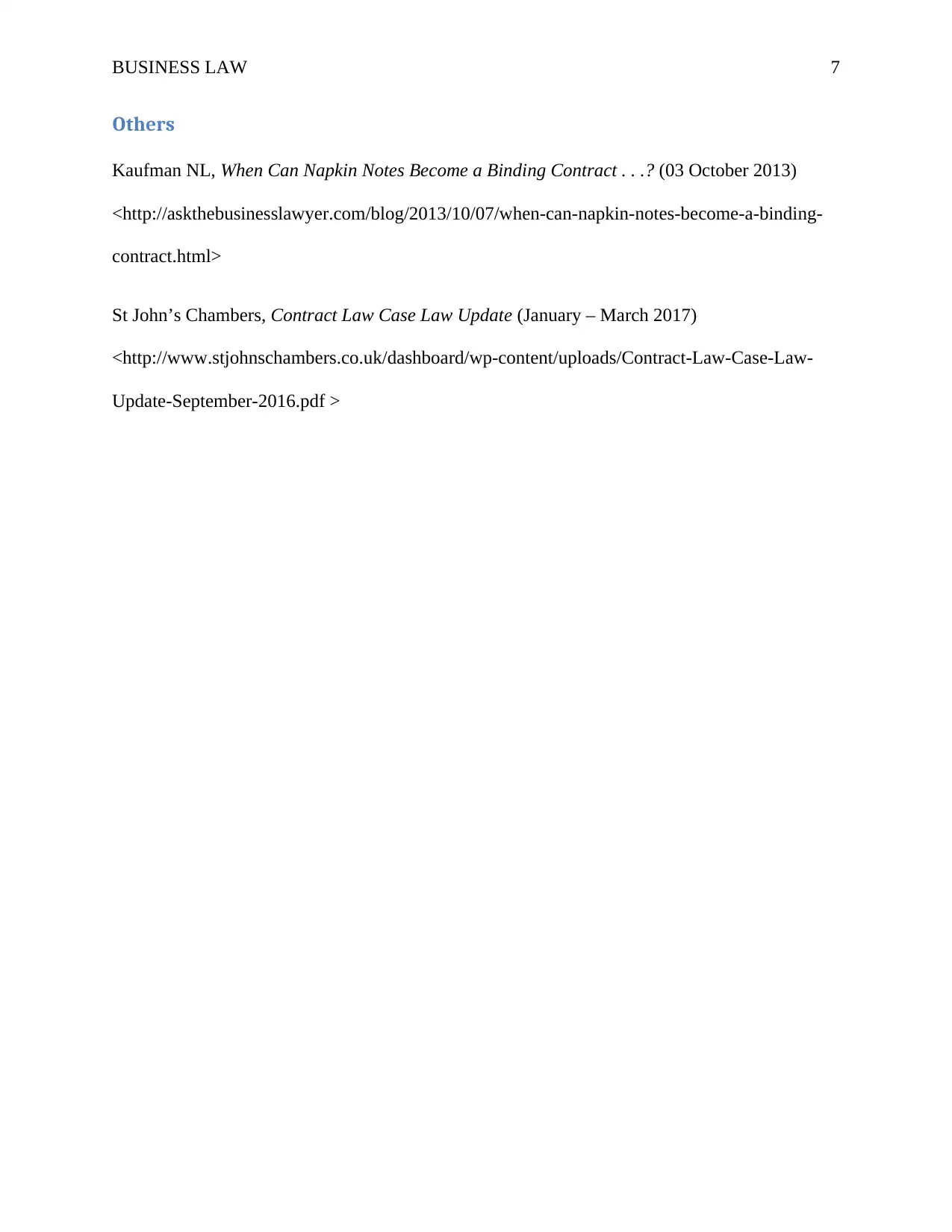
BUSINESS LAW 7
Others
Kaufman NL, When Can Napkin Notes Become a Binding Contract . . .? (03 October 2013)
<http://askthebusinesslawyer.com/blog/2013/10/07/when-can-napkin-notes-become-a-binding-
contract.html>
St John’s Chambers, Contract Law Case Law Update (January – March 2017)
<http://www.stjohnschambers.co.uk/dashboard/wp-content/uploads/Contract-Law-Case-Law-
Update-September-2016.pdf >
Others
Kaufman NL, When Can Napkin Notes Become a Binding Contract . . .? (03 October 2013)
<http://askthebusinesslawyer.com/blog/2013/10/07/when-can-napkin-notes-become-a-binding-
contract.html>
St John’s Chambers, Contract Law Case Law Update (January – March 2017)
<http://www.stjohnschambers.co.uk/dashboard/wp-content/uploads/Contract-Law-Case-Law-
Update-September-2016.pdf >
1 out of 7
Related Documents
Your All-in-One AI-Powered Toolkit for Academic Success.
+13062052269
info@desklib.com
Available 24*7 on WhatsApp / Email
![[object Object]](/_next/static/media/star-bottom.7253800d.svg)
Unlock your academic potential
Copyright © 2020–2025 A2Z Services. All Rights Reserved. Developed and managed by ZUCOL.





